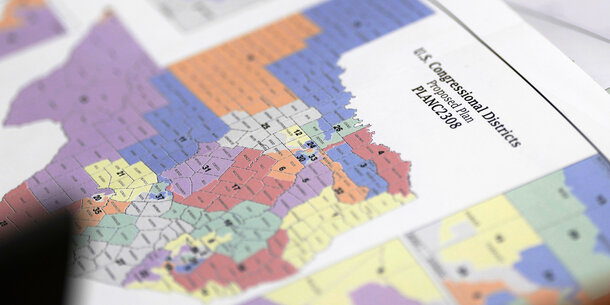In a major victory for fair maps Wednesday, the New York Court of Appeals struck down the state’s congressional and state senate district maps and ordered them redrawn by a court-appointed neutral expert in time for the 2022 midterms.
The New York case is the latest where voters — both Democrats and Republicans — have turned to state courts and state constitutions to ensure fair voting maps. The increased prominence of state courts is a shift from the past, when most claims about partisan gerrymandering were litigated in federal court. But the U.S. Supreme Court’s 2019 ruling barring courts from hearing partisan gerrymandering claims under the federal constitution and the subsequent failure of Congress to pass new federal anti-gerrymandering legislation has left state courts the last line of defense against extreme gerrymandering.
This cycle, state courts have invalidated Republican-drawn congressional maps in North Carolina, Ohio, and Kansas and Democratic-drawn congressional map in Maryland and now New York on partisan gerrymandering grounds, and a closely watched state court case challenging Florida’s aggressively gerrymandered congressional map is pending. Legislative maps have also been struck down so far this redistricting cycle by state courts in Alaska, North Carolina, Ohio, and Tennessee.
The congressional map originally passed by New York’s Democratic controlled legislature on party lines was expected to transform a congressional delegation that had 19 Democrats and 8 Republicans into one with 22 Democrats and only 4 Republicans. (New York lost a congressional seat after the 2020 Census.)
In ordering the maps to be redrawn, the high court held that Democratic lawmakers had not followed the process mandated by the New York State Constitution for adopting maps. It also found that the congressional map was an unconstitutional partisan gerrymander under reforms approved by New York voters in 2014. However, the court reversed a lower court ruling also striking down the state assembly map since no party had raised challenges to that map.
The redrawing of New York’s congressional and state senate maps now will be overseen by the state trial court in Steuben County, which has appointed Carnegie Mellon University professor Jonathan Cervas to propose new maps with input from stakeholders and other interested parties. The new ruling endorsed the lower court’s existing order directing Cervas to hold a hearing on proposed congressional maps on May 6 and to submit a proposed map by May 16. He will submit a final congressional map to the court by May 24. A similar fast-track schedule is likely to be adopted for new state senate maps.
The New York Court of Appeals ruling recognized that as a result of the need to redraw maps “it will likely be necessary to move the congressional and senate primary elections [from June] to August” but said that it was confident that the trial court, in consultation with election officials, could develop a new, workable schedule. The court rejected Democratic lawmakers’ request that they first be given an opportunity to adopt new maps, finding that “the procedural unconstitutionality of the congressional and senate maps is, at this juncture, incapable of a legislative cure.”
When the U.S. Supreme Court ruled in 2019 that partisan gerrymandering claims were beyond the reach of federal courts, many despaired that the Court was opening the door to unchecked abuses. The good news for voters, however, is that state courts have been increasingly willing to step up where federal courts have stepped out. And in contrast to federal courts, which befuddlingly struggled for decades over the proper standard for gauging gerrymandering, state courts have found the issue to be straightforward, manageable, and well within the scope of traditional functions performed by judges.
To be sure, state courts are unlikely to be a complete panacea for gerrymandering, so federal and state-level reforms remain critical. But in the growing string of state court victories, the fight for fair maps is showing unexpected vigor and American voters are the winner.



